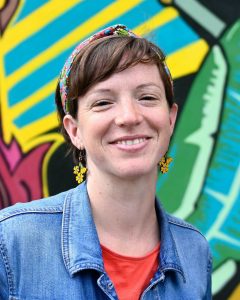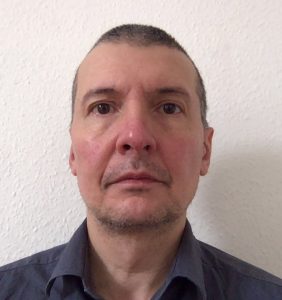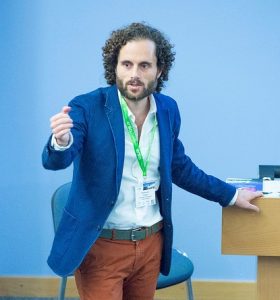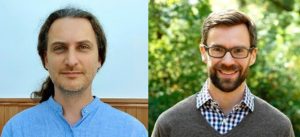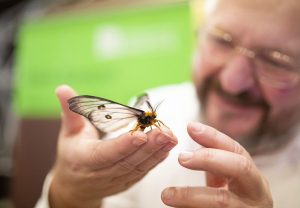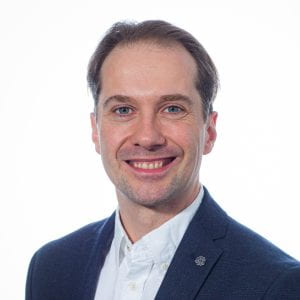
From his early days as a computer scientist at Imperial College, through to his present cross-disciplinary role at the University of Bristol with both the Medical and Veterinary Schools, Professor Andrew Dowsey has been an advocate for multidisciplinary team work. Over the course of his career, spanning his time in London, Texas, Manchester, Liverpool and now Bristol, this has seen him work with colleagues and stakeholders across the UK and USA to deliver innovative ideas and cutting-edge methodologies for the benefit of clinical practice and food security.
His Enterprise Fellowship is an extension of his Team Science approach, which aligns with the global One Health agenda – optimising health outcomes for animals and humans through an integrated approach to medicine, specifically antimicrobial resistance (AMR). In a collaborative effort involving both internal and external experts in microbiology, machine learning, bacterial genomics and public health, Professor Dowsey hopes to develop a time-critical diagnostic tool for the clinical detection of antibiotic-resistant infections.
You have several roles at the University, working on both human and animal health, though you started out as a data scientist. How did you get here?
My fascination with data science was more about what computers could do for us, rather than how they worked under the hood. During my degree in Computer Science at Imperial, I had been focused on 3D graphics and multimedia. At the time, my role was very much within Engineering rather than Health Science. I wasn’t originally planning on doing a PhD either, but then I met my future supervisor, who invited me to have a conversation after he became intrigued when he saw me working on with my face pressed up against the computer screen examining a video processing algorithm I’d developed. When I realised I could apply this interest to research in medical imaging, I never really looked back.
I started out exploring medical image computing. From that and from other people I met, I got into health data and diagnostics. When I came to Bristol in 2016, I’d been working with clinicians and surgeons for a number of years, and thought perhaps I could work with vets too. That opened my eyes to the One Health agenda, and that’s how I got into antimicrobial resistance, bugs and bacteria.
You’re an enthusiastic proponent of “team science”. Why is that?
When I started out at Imperial, I was based in the computer department, but we moved to the Institute of Biomedical Engineering so I was doing a lot of collaboration across the disciplines from the outset. When I got my first lectureship in Manchester in the Faculty of Health Sciences, working in a drug discovery centre in their NHS Foundation Trust, on bioinformatics and data science for biomarker discovery with mass spectrometry, I found myself in a truly multidisciplinary environment and experienced the benefits of being properly embedded with analytical chemists, bio-scientists and clinicians, rather than collaborating from a distance and only interacting sporadically. That approach gave me a much better understanding of what drives people. Since then, I’ve pushed for this way of being thoroughly embedded with the other disciplines.
You spearheaded the creation of the John Oldacre Centre for Dairy Welfare and Sustainability at Bristol Veterinary School. Tell us about that.
Bristol Veterinary School has one of the biggest animal welfare and behaviour groups in the world. It has a working dairy farm that is used for teaching purposes, so I felt it would be great if we could supercharge the farm for research. It’s thanks to the fact that I’m so close to that environment, with my joint role across the schools, that I was able to go down to the farm on multiple occasions and get a real sense of what they do, to understand what concerns farmers have. As a result, we’ve built a centre using Artificial Intelligence in combination with the welfare, sustainability and AMR expertise on site, that actually makes a practical difference. For instance, we’re creating an early detection system based on how cows tend to change their social and interactive behaviours when they get a subclinical illness – much like humans avoid each other when they have a cold. Rather than purely monitoring them for explicitly present conditions, it’s opening up the prospect of using the technology to detect disease much earlier than having to wait until it’s apparent.
Your Enterprise Fellowship is specifically focused on AMR in a clinical setting. How does this build on the work you’ve been doing?
Through working on AMR, first with vets and then with clinicians at Bristol Royal Infirmary and Southmead Hospital, I’ve come to understand the clinical workflow, particularly how clinicians use mass spectrometry to identify bugs and bacteria from blood samples. I realised I could bring in the expertise and experience that my team has in mass spectrometry for the benefit of improving bacterial diagnostics; we’ve developed methods that can potentially determine the strain type and the resistance of a bug, based on data, which provides a faster response than waiting for the results from the pathology centre.
What do you hope to achieve/discover?
Currently, infection diagnostics take around 24 hours to confirm bacterial infection and a further 24 hours to determine antibiotic susceptibility. The problem is that the patients with things like severe septicaemia don’t have time to wait a day or two for the clinician to determine the right antibiotics. Our studies have shown that prediction models that use machine learning can accelerate the diagnostic process. If we can translate this technology into clinical use, that could substantially accelerate appropriate prescribing. The idea is that we can give the clinician more information about the bug or the bacteria, to help them understand the strain and whether it exhibits a particular resistance or toxicity mechanism, in such a way that a doctor can make a confident decision on that basis.
In the context of AMR, doctors also have to be concerned about AMR stewardship and not overusing certain drugs. This is also something that our approach could help with indirectly through better prescribing, and there are potential applications in outbreak detection and surveillance, too.
Your EF is focused on understanding and navigating the commercialisation process that could help take your technology into clinical practice. Was that always your intention?
I want to learn about the things I don’t know – regulations, knowledge transfer, all the things that oftentimes can feel more complicated than they are until you actually tackle them. I’ve been involved in lots of projects over the years since I was a post-doc working with multiple industrial stakeholders. I feel confident in that environment, but I don’t feel at all confident in developing my work into commercial translation because I haven’t done that before.
When I got into academic research, my passion was for getting all the way down the pipeline with an idea to the point of having something that could actually be used – that’s still my prime motivation. We’ve been talking to experts in the transfer of medical technologies, which has motivated me to look further into the limitations of artificial intelligence for diagnostics in clinical settings, especially given the potential for bias against protected characteristics – for instance, where diagnostic tools are not always as robust as they could be.
In a fundamental research context, our focus is on what information we can extract and how can that be translated into clinical use. There are lots of directions we can take this – that excites me. Talking to stakeholders and learning more about the market will reveal what we do next. Will it be a spinout or will we look at licencing? Or will this idea lead to something completely unexpected and solve a problem we’re not yet aware of? Time will tell! It’s virtually never the case that the idea you have at the start is the one you end up with at the end. I’m excited to find out which direction this will take.
Professor Andrew Dowsey is a Turing Fellow and Chair in Population Health Data Science in the Faculty of Health Sciences, where he is also the Director for Innovation and Enterprise.

